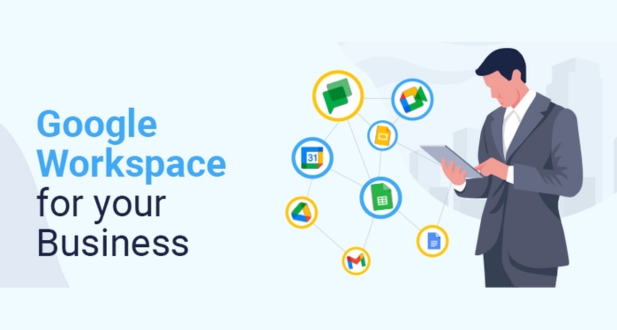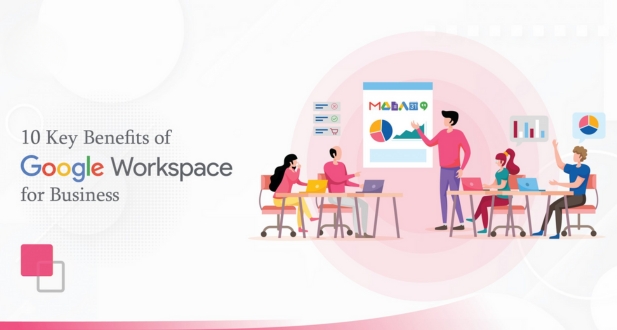Introduction
Definition of Google Workspace Enterprise
Google Workspace Enterprise represents a comprehensive suite of cloud-based collaboration and productivity tools tailored for large enterprises. Formerly known as G Suite Enterprise, this solution combines email, file storage, video conferencing, and productivity applications within a unified platform. Designed to meet the unique demands of large organizations, Google Workspace Enterprise integrates seamlessly with business processes to enhance communication, streamline workflows, and foster collaboration on a grand scale.
Importance of Tailored Solutions for Large Enterprises
In the realm of large enterprises, one size rarely fits all. The sheer scale, complexity, and diverse needs of these organizations necessitate solutions that can be finely tuned to their specific requirements. Google Workspace Enterprise acknowledges this reality, offering a customizable suite of tools that can be adapted to align with the unique workflows, security protocols, and collaboration dynamics inherent in large enterprises. This tailored approach ensures that the enterprise can leverage the full potential of Google Workspace to optimize its operations.
Overview of Google Workspace’s Role in Enterprise Productivity
At the heart of enterprise productivity lies effective collaboration and seamless communication. Google Workspace serves as a catalyst for these essential elements by providing a centralized hub where teams can collaborate in real-time, access shared documents, and conduct virtual meetings effortlessly. The platform’s integration with familiar tools such as Gmail, Google Drive, and Google Meet streamlines workflows, allowing large enterprises to maintain a high level of productivity even in dynamic and geographically dispersed work environments.
In addition to productivity tools, Google Workspace Enterprise places a strong emphasis on security and compliance features. These aspects are crucial for large enterprises dealing with sensitive information and regulatory requirements. As we delve into the intricacies of Google Workspace Enterprise, we will explore its features, benefits, and how it addresses the distinct needs of large enterprises in fostering collaboration, ensuring data security, and driving overall productivity.
Understanding Enterprise Plans
Overview of Google Workspace Enterprise Plans
Google Workspace Enterprise offers a range of plans designed to cater specifically to the needs of large enterprises. These plans provide a comprehensive suite of tools that go beyond the offerings of Basic and Business packages. The focus is on delivering advanced features, robust security measures, and enhanced administrative controls to meet the demands of complex organizational structures.
The Enterprise plans elevate the standard Google Workspace experience, providing organizations with a powerful set of collaboration tools, productivity applications, and enterprise-level security features. These plans are structured to empower large enterprises with the tools they need to foster efficient communication, collaboration, and productivity at scale.
Comparison of Basic, Business, and Enterprise Packages
Basic Plan:
- Ideal for small businesses and startups.
- Offers essential collaboration tools like Gmail, Google Drive, and Google Calendar.
- Limited administrative controls and security features.
Business Plan:
- Suited for growing businesses.
- Includes advanced collaboration tools like Google Meet and expanded storage.
- Enhanced administrative controls and security features.
Enterprise Plans:
- Tailored for large enterprises with complex needs.
- Comprehensive set of collaboration tools, productivity applications, and advanced security features.
- Customizable administrative controls to manage users and resources effectively.
- Priority support and service level agreements (SLAs) for enterprise-grade reliability.
Scalability and Flexibility for Large Enterprises
One of the key strengths of Google Workspace Enterprise is its scalability and flexibility. Large enterprises often undergo dynamic changes, and the ability to scale services according to evolving needs is paramount. Google Workspace Enterprise plans are designed to accommodate the growth, expansion, and changing demands of large organizations seamlessly.
The flexibility is reflected in the customizable nature of Enterprise plans. Organizations can tailor their Google Workspace experience to align with specific workflows, compliance requirements, and security protocols. This adaptability ensures that Google Workspace remains an agile and integral part of the enterprise’s infrastructure, supporting its goals and operations as they evolve.
As we delve deeper into the features and benefits of Google Workspace Enterprise, we will explore how these plans empower large enterprises to harness the full potential of collaborative and productivity tools while maintaining the scalability and flexibility required in the ever-changing business landscape.
Features and Benefits
Google Workspace Enterprise stands out for its rich array of features, providing large enterprises with a comprehensive suite of collaboration tools, productivity applications, and robust security measures. Let’s delve into the distinct features and benefits across key areas:
Collaboration Tools
- Gmail for Professional Email Communication:
Enterprise-level Gmail offers a professional and efficient email communication platform.
Features include advanced search capabilities, organized inboxes, and powerful filtering options.
Integration with other Google Workspace tools ensures seamless collaboration.
- Google Drive for Sharing and Secure File Storage:
Google Drive provides a secure and centralized cloud storage solution.
Advanced sharing settings enable controlled access to documents, ensuring confidentiality.
Real-time collaboration features allow teams to work on documents simultaneously.
- Google Meet for Video Conferencing:
Google Meet facilitates high-quality video conferencing for remote and distributed teams.
Features include screen sharing, real-time captions, and integration with Calendar for scheduling.
Enterprise-level security measures ensure confidentiality and reliability.
Productivity Applications
- Google Docs, Sheets, and Slides:
- Collaborative document editing with real-time updates enhances teamwork.
- Version history and commenting features streamline the editing and review process.
- Seamless integration with Drive and other collaboration tools.
- Google Calendar for Efficient Scheduling:
- Calendar simplifies scheduling and coordination across teams.
- Features include shared calendars, event reminders, and integration with Meet for virtual meetings.
- Customizable settings cater to diverse scheduling needs within large enterprises.
- Google Forms for Easy Data Collection:
- Forms facilitate easy data collection through customizable surveys and forms.
- Integration with Sheets streamlines data analysis and reporting.
- Ideal for gathering feedback, conducting surveys, and managing information flow.
Administrative Controls and Security Features
- Admin Console for Centralized Management:
- The Admin Console offers a centralized hub for managing users, devices, and security settings.
- Customizable controls allow administrators to tailor the Google Workspace experience.
- Reporting and auditing features provide insights into user activity and system health.
- Advanced Security Measures for Data Protection:
- Google Workspace Enterprise incorporates advanced security measures such as data loss prevention (DLP) policies.
- Encryption at rest and in transit ensures the confidentiality of sensitive information.
- Robust threat detection and incident response capabilities enhance overall data protection.
- Two-Factor Authentication (2FA) for Enhanced Security:
- 2FA adds an extra layer of security by requiring additional verification beyond passwords.
- Enhances protection against unauthorized access and potential security breaches.
- Strengthens overall security posture for large enterprises dealing with sensitive data.
The robust collaboration tools, productivity applications, and advanced security features collectively empower large enterprises to foster efficient communication, streamline workflows, and safeguard sensitive information. As we explore further, we will delve into how these features seamlessly integrate, providing a unified and powerful Google Workspace experience for large-scale organizational needs.
Choosing the Right Enterprise Package
Choosing the right Google Workspace Enterprise package is a critical decision for large enterprises. This section explores the considerations and steps involved in making an informed choice.
Assessing Enterprise Needs
Large enterprises have diverse needs that evolve with the scale and nature of their operations. To choose the right Google Workspace Enterprise package, organizations must conduct a thorough assessment of their requirements. This involves:
- Scalability: Evaluate the scalability of the chosen package to ensure it can accommodate the growth and changing dynamics of the enterprise.
- Collaboration Requirements: Identify specific collaboration needs, such as video conferencing, document collaboration, and real-time communication.
- Security and Compliance: Consider the industry-specific security and compliance requirements. Google Workspace Enterprise offers advanced security features suitable for organizations dealing with sensitive data.
- Administrative Controls: Assess the administrative controls needed for managing users, devices, and security settings effectively.
Tailoring Google Workspace Plans to Business Objectives
After identifying the enterprise’s needs, the next step is to tailor the Google Workspace Enterprise plans to align with business objectives. This involves:
- Customization: Leverage the customizable features of Google Workspace to align with specific workflows, branding, and organizational structures.
- Integration with Existing Systems: Ensure seamless integration with existing systems and applications used within the enterprise to maintain workflow continuity.
- Training and Adoption: Consider the training and onboarding needs of users to maximize the adoption of Google Workspace features. This is crucial for realizing the full potential of the chosen package.
- Collaboration Culture: Align the chosen plan with the desired collaboration culture within the organization. This could include fostering open communication, transparency, and teamwork.
Understanding Pricing Structures and Value Proposition
Understanding the pricing structures and the value proposition of each Google Workspace Enterprise plan is vital for making an economically sound decision. Consider the following factors:
- Feature Comparison: Compare the features offered in each plan to ensure they align with the enterprise’s needs.
- User Licensing: Understand the user licensing models and how they impact costs as the organization scales.
- Support and SLAs: Evaluate the level of support and service level agreements (SLAs) provided in each plan. This is crucial for maintaining a reliable and efficient Google Workspace environment.
- ROI Analysis: Conduct a thorough return on investment (ROI) analysis to assess the economic benefits and long-term value derived from the chosen plan.
By conducting a comprehensive assessment of needs, aligning plans with business objectives, and understanding the pricing structures, enterprises can make an informed decision when choosing the right Google Workspace Enterprise package. This strategic approach ensures that the selected plan not only meets the current needs but also positions the organization for future growth and success.
Integration with Third-Party Apps
Google Workspace Enterprise extends its functionality by offering seamless integration with third-party applications, providing enterprises with a versatile and customized digital ecosystem.
Google Workspace Marketplace Overview
The Google Workspace Marketplace serves as a centralized hub for a diverse range of third-party applications that seamlessly integrate with Google Workspace. This marketplace offers a curated selection of apps, add-ons, and extensions that enhance the capabilities of Google Workspace tools. Enterprises can explore and leverage these applications to tailor their Google Workspace experience to their specific needs.
Enhancing Functionality with Integrated Applications
- Specialized Tools: The Marketplace features applications that cater to specialized business needs, such as project management, customer relationship management (CRM), and marketing automation. These tools empower enterprises to extend the functionality of Google Workspace and address unique requirements.
- Collaboration Amplified: Integrated applications enhance collaboration by providing additional features and functionalities within familiar Google Workspace tools. For example, project management apps seamlessly integrate with Google Drive and Calendar, allowing teams to manage projects directly from their collaboration environment.
- Productivity Boost: Enterprises can choose from a variety of productivity-boosting applications that integrate with Google Workspace. These applications enhance document creation, data analysis, and overall workflow efficiency. By seamlessly connecting these tools, enterprises create a unified and streamlined work environment.
Streamlining Workflows with Seamless Integrations
- Workflow Automation: Integrated applications enable workflow automation by connecting various processes and tools. This automation eliminates manual tasks, reduces errors, and improves overall operational efficiency. For example, integrating a workflow automation tool allows enterprises to automate approval processes directly from Gmail.
- Seamless Data Transfer: Many third-party applications integrate seamlessly with Google Workspace, allowing for the effortless transfer of data between different tools. This guarantees accuracy and uniformity of data throughout the company.
- Centralized Access: Integration provides a centralized access point for various applications, reducing the need for users to switch between different platforms. This centralized access enhances user experience and facilitates a more cohesive digital workspace.
In conclusion, the integration with third-party applications through the Google Workspace Marketplace empowers enterprises to tailor their digital environment to their specific needs. By enhancing functionality, boosting productivity, and streamlining workflows, these integrations contribute to a more efficient and customized Google Workspace experience for large enterprises. Enterprises can leverage this extensive ecosystem to create a digital workspace that aligns seamlessly with their unique business requirements.
Best Practices for Enterprise Productivity
Enhancing enterprise productivity within Google Workspace requires a strategic approach that leverages collaboration, administrative controls, and robust security protocols. Here are key best practices to optimize productivity:
Leveraging Collaboration for Team Productivity
- Real-Time Collaboration Tools: Encourage the use of real-time collaboration tools such as Google Docs, Sheets, and Slides. These tools facilitate simultaneous editing and feedback, fostering a collaborative environment where teams can work together seamlessly.
- Unified Communication: Leverage communication tools like Google Meet and Chat to facilitate unified communication. Schedule regular video meetings, use instant messaging for quick updates, and ensure that all team members are on the same page.
- Project Management Integration: Integrate project management tools from the Google Workspace Marketplace to streamline workflows. Connecting tools like Asana or Trello allows teams to manage projects efficiently within their collaboration environment.
Utilizing Administrative Controls for Efficient Management
- Customized User Policies: Utilize the Admin Console to set up customized user policies that align with organizational workflows. Tailor settings based on roles and responsibilities to ensure that users have the necessary access and permissions.
- User Onboarding and Training: Implement a robust onboarding and training program for new users. Provide comprehensive training resources to familiarize users with Google Workspace features, ensuring they can maximize productivity from day one.
- Automated Workflows: Explore workflow automation using tools like Google Workspace Add-ons. Automate repetitive tasks, approvals, and document processes to reduce manual workload and increase overall operational efficiency.
Implementing Security Protocols to Safeguard Business Data
- Data Loss Prevention (DLP): Implement DLP policies to prevent the unauthorized sharing of sensitive information. Customize DLP rules to align with industry compliance standards and protect confidential business data.
- Two-Factor Authentication (2FA): Enforce 2FA across the organization to add an extra layer of security. Require users to authenticate their identity using a secondary method, enhancing overall security and safeguarding against unauthorized access.
- Regular Security Audits: Perform routine security evaluations and audits to find weaknesses. Use the reporting and analytics features in the Admin Console to monitor user activity, ensuring compliance with security protocols.
By integrating these best practices into the daily workflows of Google Workspace Enterprise users, organizations can create an environment that prioritizes collaboration, efficient management, and robust security. This holistic approach contributes to a culture of productivity, innovation, and data integrity within the enterprise, ensuring that Google Workspace is optimized to meet the unique needs of large organizations.
Anticipated Developments and Factors to Take into Account
As enterprises navigate the ever-evolving digital landscape, it’s crucial to anticipate future trends and consider how Google Workspace can adapt to emerging challenges and opportunities.
Evolving Enterprise Needs in the Digital Landscape
- Remote and Hybrid Work: The trend towards remote and hybrid work models is likely to persist. Google Workspace needs to continually enhance features that support collaborative and flexible work environments, ensuring seamless connectivity for distributed teams.
- Integration of AI and Automation: Enterprises will increasingly rely on artificial intelligence (AI) and automation to streamline processes. Google Workspace should evolve to incorporate AI-driven features, such as intelligent task automation and predictive analytics, to enhance productivity.
- Focus on Employee Experience: Future enterprise needs will prioritize the employee experience. Google Workspace should consider features that enhance collaboration, well-being, and work-life balance to meet the evolving expectations of the workforce.
Google Workspace’s Response to Emerging Trends
- Innovations in Collaboration Tools: Google Workspace will likely continue to innovate its collaboration tools, introducing features that improve real-time communication, document collaboration, and project management.
- Enhanced Security Measures: With the growing emphasis on cybersecurity, Google Workspace is expected to enhance its security measures. This includes continuous improvements in data encryption, threat detection, and compliance features to safeguard sensitive enterprise information.
- AI-Driven Productivity: Google Workspace may integrate more AI-driven productivity tools to assist users in managing their workflows efficiently. This could involve AI-driven insights, automated task management, and personalized user experiences.
Preparing for Future Upgrades and Enhancements
- User Training and Adoption: As Google Workspace introduces new features, robust training programs will be essential to ensure that users are proficient in utilizing the latest tools. User adoption strategies should be designed to embrace and maximize the benefits of future upgrades.
- Flexible Infrastructure: Google Workspace should maintain a flexible infrastructure that allows for easy integration with emerging technologies. This flexibility ensures that enterprises can adapt to new tools and platforms seamlessly.
- Agile Development and Updates: To stay ahead of the curve, Google Workspace should adopt an agile approach to development and updates. Regular releases of new features and enhancements will keep the platform aligned with the dynamic needs of large enterprises.
In conclusion, Google Workspace’s responsiveness to evolving enterprise needs, commitment to innovation, and preparation for future upgrades are pivotal in ensuring that it remains a leading choice for large enterprises seeking a collaborative and efficient digital workspace. By anticipating trends and staying adaptable, Google Workspace will continue to play a vital role in shaping the future of enterprise productivity.
Conclusion
Google Workspace Enterprise stands as a dynamic solution poised to meet the ever-evolving needs of large enterprises in the digital era. Through its robust suite of collaboration tools, productivity applications, and advanced administrative controls, Google Workspace empowers organizations to foster seamless collaboration, enhance productivity, and fortify their digital infrastructure.
The best practices highlighted, encompassing collaboration strategies, administrative efficiency, and stringent security protocols, serve as pillars for driving enterprise productivity within the Google Workspace environment. By leveraging the collaborative potential, optimizing administrative capabilities, and prioritizing security measures, enterprises can create a digital ecosystem that thrives in the modern business landscape.
Anticipating future trends is vital, and Google Workspace’s commitment to innovation, security enhancements, and adaptation to emerging technologies positions it as a strategic partner for enterprises preparing for the challenges ahead. As the enterprise landscape evolves, Google Workspace’s agile approach to updates and its focus on user experience and flexibility ensure its continued relevance and effectiveness in meeting the dynamic demands of large-scale organizations. In embracing these principles, enterprises can harness the full potential of Google Workspace Enterprise to drive productivity, foster innovation, and navigate the future of collaborative work seamlessly.
Google Workspace Enterprise offers advanced features tailored for large-scale enterprises. It includes additional security measures, such as data loss prevention and advanced endpoint management. Enhanced collaboration tools, like Smart Canvas in Google Docs, provide an elevated user experience. Enterprise also offers comprehensive analytics and reporting features for administrators.
Google Workspace Enterprise prioritizes security through features like advanced data loss prevention (DLP), two-factor authentication (2FA), and granular access controls. The platform adheres to industry-leading security standards and undergoes regular security audits. Enterprises can also benefit from Google’s robust infrastructure, which includes secure data centers and encrypted communication.
Absolutely. Google Workspace Enterprise is designed to scale with the evolving needs of large enterprises. The flexible infrastructure accommodates a growing user base, and the admin console allows for easy management of user accounts, permissions, and policies. This scalability ensures that Google Workspace remains an effective solution as your organization expands.
Google Workspace Enterprise is well-suited for remote and hybrid work scenarios. Its collaboration tools, such as Google Meet and Google Chat, facilitate real-time communication. Additionally, features like Google Drive enable seamless file sharing and collaboration, fostering productivity regardless of the physical location of team members.
Google Workspace Enterprise integrates AI to enhance productivity. AI-driven features, such as Smart Compose in Gmail and Smart Suggestions in Google Docs, automate repetitive tasks and provide intelligent suggestions, saving time for users. This integration of AI aims to create a more intuitive and efficient user experience within the Google Workspace Enterprise environment.










